On this third and closing entry in our Over the Backyard Wall trilogy, we’ll be taking a deep look into the vacation which the collection is constructed round.
As such – truthful warning – it’s additionally my lengthy overdue love letter to Hallowe’en.
To start with, let’s acknowledge that there’s completely no intrinsic motive why this story needed to happen on Hallowe’en – it was a deeply intentional alternative on McHale’s half, and ought to be thought of deeply vital. Different occasions of 12 months might be simply as vital: Christmas is the obvious vacation to discover concepts of magic and household and belonging; summer time trip is frequent setting for tales about youngsters coming of age, journey, and self-acceptance; commencement, Candy Sixteens, final days of college, homecoming, New 12 months’s Eve, bar mitvahs, Valentine’s Day, proms, formals, and band recitals are all glorious rites of passage or testing occasions for teenage characters who’re struggling to simply accept themselves.
“All That Was Misplaced is Revealed”:
A 3-Half Collection Analyzing Over the Backyard Wall‘s
Macabre Magnificence, Joyful Whimsy,
and Profound Philosophy
PART THREE

On the floor, plot-wise, the apparent resolution is that it permits the Brothers to be dressed anachronistically, disguising their trendy origins – and there is reality to that. Nevertheless, I feel the deeper cultural that means behind Hallowe’en – this imaginative pageant of loosely-held contradictions and existential feelings – deserves the credit score.
One of many apparent influences of the modern scenes within the final two episodes is the Peanuts 1966 Hallowe’en Particular, It’s the Nice Pumpkin, Charlie Brown, which additionally follows the misadventures of two socially awkward boys (the gloomy, Wirt-like Charlie Brown and the imaginative, Greg-ish Linus Van Pelt) as they navigate rejection and embarrassment from their friends. The stakes are excessive on this cutthroat kids’s campaign – particularly for Charlie Brown (who’s unintentionally invited to a celebration, tossed rocks in lieu of sweet, and taunted for his pumpkin-shaped head).
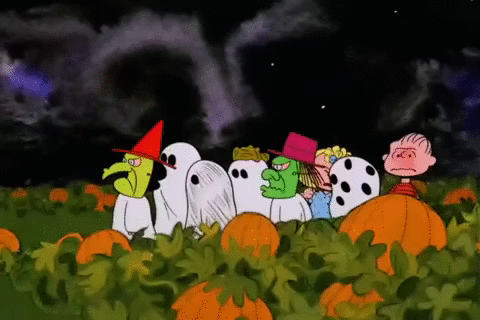
Like Lord of the Flies, Peanuts has an anxious, chaotic world with out adults the place the kids spar for energy and affect – one the place the weak are ostracized or tormented. It’s a lot, a lot harsher than Wirt’s personal highschool expertise (though he clearly believes himself to be some sort of irredeemable, undesirable “Charlie Brown”).
“EVERYONE’S GOT A TORCH TO BURN”:
The Transcendental Energy of Embracing Grief
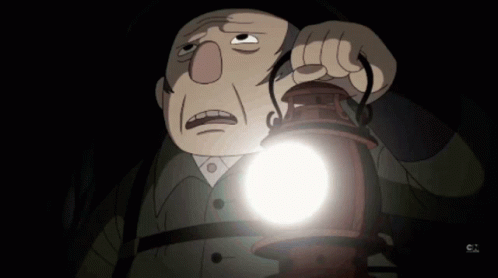
I point out that this thought first occurred to me in the course of the closing episode, and with good motive. That is the episode the place we see the clearest, most heartbreaking instance of “good grief”: the Woodsman acknowledging the madness to which his unprocessed grief has pushed him. He realizes in surprised horror that his false hope has deluded him into allying himself with the Beast.
In a actual world instance of this, we would think about a father grieving a daughter misplaced to her despair, who – by failing to course of his trauma – permits himself to be manipulated into hopeless inaction by his personal despair. Sadly, as an alternative of feeling his emotions, and utilizing this newly-restored emotional power to boost consciousness, begin a basis, or mentor different hurting children, he may selected to remain at residence, misplaced in self-isolation, letting the Beast of Hopelessness run his life.

When the Woodsman confronts his concern (that by dousing the sunshine and experiencing the emotional darkness he’ll “lose” his daughter) he is ready to really feel, transfer by means of, and course of his trauma. He realizes that his daughter continues to be alive in his coronary heart, and summons the braveness to let go of the misleading flame – a fireplace saved alive by the gasoline created by means of the Beast’s continued marketing campaign towards humanity.
He sees that by passively taking part in the Beast’s recreation he has been unintentionally complicit within the harvesting of different misplaced kids’s souls. Disgusted and horrified, he choses to confront actuality, sever ties along with his depraved grasp, and permit himself to take a seat within the crushing darkness of his grief, not afraid to take action.

Sitting in darkness – accepting and feeling our scary emotions – is what Hallowe’en is essentially all about. And but, as I’ll get to within the conclusion, I’m very a lot afraid that we now have misplaced contact with what Hallowe’en has finished for people over the centuries, what it could do for us as we speak, and what it’s actually, actually about.
I feel that, far too typically, we see it as a time to masochistically languish in darkness – in existential hopelessness and pessimism – with out accessing its pleasure, mild, and group.

Just like the Unknown’s ubiquitous half-moon, Hallowe’en has traditionally been a season outlined by stability – between concern and hope, isolation and group, the fabric and the magical, actuality and creativeness – and considered one of its core initiatives is the embracing and redemption of concern.
Throughout October, we nonetheless deck out our homes in symbols related to concern and the unknown (lower-case “u”) and commit our studying and leisure to matters which are unsettling and even terrifying. It’s a managed burn of hysteria – publicity remedy of our existential anxieties – and if finished with comply with by means of, it may be astonishingly life-affirming.

What we now have misplaced, I concern, is the braveness to decide to that comply with by means of: we gin up our anxieties of murderers, torture, loneliness, vulnerability, dying, and oblivion, however so sometimes, it appears to me, will we take the cue from Greg’s Gospel (see our earlier put up on that) to joyfully and trustingly give up ourselves over to the knowledge of uncertainty.
By combating towards it – even whereas surrounded by plastic ghouls and binging zombie films – we by no means come out on the opposite aspect, and grow to be metaphorically misplaced within the Unknown of our nervousness and self-consciousness. We by no means sanctify our nervousness with humanity and love.
“ALL THAT WAS LOST IS REVEALED”:
Reclaiming & Sanctifying Demise in Group
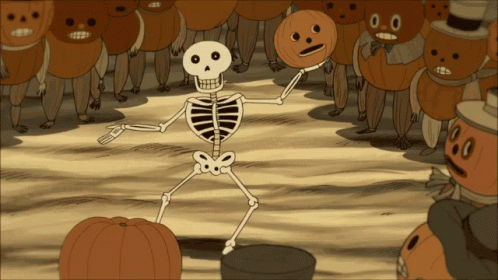
This concept – the vital must confront and course of nervousness – replays frequently all through OtGW, however it’s first and most fantastically illustrated in “Arduous Occasions on the Huskin’ Bee” the place Wirt is confronted with a colony of resurrected skeletons who’ve re-envisioned their lonely destiny by donning vegetable fits to recontextualize their predicament: sure, they’re lifeless, however no – their deaths haven’t been in useless, nor are they to be pitied, feared, or seen as ineffective.
That is what each Over the Backyard Wall and Hallowe’en itself are inclined to do with our isolation and concern. Just like the bony residents of Pottsfield – skeletons redeemed and consecrated with a dignifying go well with of jack-o-lanterns – OtGW builds a stunning, autumnal exterior round its heavy, central theme: the quiet great thing about confronting your mourning and mortality with childlike belief. As such, the present’s humor and nostalgia domesticates its innate darkness: to not disguise it, however to sanctify it.

In the identical means, when Larry the skeleton is reclaimed from his unmarked grave within the Potter’s Area, he isn’t ashamed or self-conscious about his decomposed standing, and he doesn’t don the pumpkins and corn shocks like fig leaves to cover his nature from his group. As a substitute, his pals joyfully rush to reclaim him from dying, masking him within the fruits of the harvest like a martyr being wearing a clear, white gown.
His pals aren’t uncomfortable along with his mortality, neither is he, however they are fast to make use of the pumpkin go well with to symbolically bless his bones. In the identical means that particular clothes are used at transitional ceremonies (robes at graduations, robes at weddings, and chasubles in non secular providers), Larry’s pals present him with vegetable vestments to mark his transcendent transition from dying.

Likewise, Larry – and the opposite Pottsfield residents earlier than him – died and was buried (like a seed) in a pauper’s grave, apparently forgotten and not helpful to the world. However when his group had him harvested (like a ripe vegetable) from his dormancy within the floor, his life was validated, celebrated, and reclaimed.
Briefly, grief and mourning – the confrontation of sad truths – are used to reverse the curse of mortal angst. By accepting Larry’s dying and coming head to head along with his bony stays, his mourning group is ready to enfold him into their embrace and recuperate reference to him. By letting go, we enable ourselves to reclaim and recuperate.
This lesson recurs all through the collection:
-
Mr. Langtree recovers his failing enterprise and dying dream by accepting actuality
-
Ms. Langtree recovers that no-good Jimmy Brown by going public together with her grief
-
Mr. Endicott recovers his peace of thoughts by confronting the fact of his “ghost”
-
Lorna recovers her freedom by accepting the darkish, taboo nature of her cannibalistic curse
-
Greg recovers Wirt’s salvation by acknowledging his lack of management and brazenly atoning for it
-
Greg recovers his interior baby by accepting himself and embracing/sharing his eccentric passions
-
The Woodsman recovers his misplaced daughter by confronting his grief and letting her “go”
“CONTENT TO BE SLIGHTLY FORLORN”
Hallowe’en’s Historic, Theraputic Function in Processing Concern, Anxiousness, & Grief

With the approaching onslaught of chilly climate, restricted sources, starvation, and illness, these Druidic communities knew that many amongst them wouldn’t reside to see one other summer time – this was assured – and certainly, lots of them may be seeing each other for the final time as they celebrated collectively across the communal bonfire, earlier than parting methods into the darkish evening.



All Saints’ and All Souls’ Day offered the group with an intentional block of time to concurrently mourn their misplaced family members and discover consolation of their recollections. Grieving, then, was not a luxurious of the rich, however a sacred proper and responsibility for all individuals, no matter their class or affect, and one which merited a two-day pageant of observance to validate the emotional and non secular necessity of mourning.
When pagan and Christian traditions enmeshed collectively into “Hallowe’en,” their shared DNA bolstered the vacation’s contradictory tones: pleasure and grief, pleasure and nervousness, hope and concern. No matter our religions or philosophies, we’re every invited to ponder dying, mourn our traumas, and rejoice the beautiful comforts of human group and creativity.

Consequently, we’ll see in any other case regular homes instantly robed in symbols of dying: draped in cobwebs, sprouting headstones, ornamented with skeletons, and fluttering with ghosts. Certainly, the seminal emblem of Hallowe’en – the jack-o-lantern – is a pleasant little microcosm of this impulse to solid a spell over the bizarre: every porch is curiously embellished with a household of suspiciously head-shaped gourds (normally one for every resident) which – in some unspecified time in the future – disappear into the home and reemerge with a grotesque face carved into it.
The pure is emblazoned with an expression of the supernatural, simply as our monotonous, commercialized lives are briefly marked with the reminiscence of dying – the deaths of these whom we’ve misplaced, and the first one which we’ll every finally expertise.

That is much more enhanced by the widespread use of costumes: yet one more alternative for us to precise our hidden, elegant nature. By costumes, an introverted IT man can specific his unrecognized heroic nature by dressing as a strong knight, a mild elementary instructor can specific her unrecognized eroticism by dressing as a alluring witch, and a harried housewife can specific her unrecognized anxieties by dressing as a decomposing corpse bride. An angsty outsider might even gown as a bizarre elf-boy to precise his concern that his core identification is his aloof otherness. The inside is now allowed to be exterior, the nervousness is uncovered, the concern is confronted, and the hope is expressed.
By serving as a shared second to think about, mourn, and course of the assorted disparities between want and actuality Hallowe’en presents us a collective, cultural pause to acknowledge what might be, what shouldn’t be, what’s, what was, and what might be.
We are able to hope whereas we grieve and aspire whereas we settle for, permitting our minds to drift out and in of various emotional states with sleek allowance. In so some ways, that is what the Unknown offers: an area to really feel issues concurrently with tolerance and creativeness.

Individuals could be difficult, obscure, and even outright contradictions within the Unknown, however none of their compatriots appear to care or choose them. Is Lorna a candy or savage? Is Endicott beneficiant or grasping? Is Pottsfield a group or a cult? Is Langtree a idealist or an fool? Is Auntie Whispers grotesque or gracious?
Within the Unknown, the knowledge of those sorts is unimportant: just like the half-moon gleaming above them, they characterize the misty in-between nature of humankind – so stuffed with potential but restricted by circumstances.
Upon returning to the waking world, Wirt carries with him this permission to be one thing in-between: it’s okay if he’s each a little bit odd and sort of a catch, and its okay if he’s misunderstood by some however accepted by others.
In true Hallowe’en trend, he has been carrying a fancy dress, masquerading as one thing which he’s not – or not solely – and with the closing of the vacation, from his hospital mattress, he seems to make the choice to simply accept himself and take away his social façade – an identification simply as fabricated as his blue-caped, pointy-hatted get-up.

The costume served a goal: it was enjoyable, offered safety, and gave Wirt’s creativeness respiratory room, however with the conclusion of the vacation, Wirt is ready to choose about his identification, to commit to it, and to stop placing up partitions and carrying disguises. He’s who he’s, and no lengthy feels the necessity to disguise himself from his friends.
On the finish of the collection, Hallowe’en has finished its magic, and Wirt crosses out of the fantasy world again into the waking world, however empowered by the teachings and progress which the Unknown afforded him.
“THE LOVELIEST LIES OF ALL”:
Utilizing Nostalgia to Mourn, Love, Really feel, & Forgive

For a lot of viewers – Gen-Xers and Elder Millennials, particularly – OtGW’s choice for the music and animation of the Nineteen Twenties and Nineteen Thirties will remind them of their grandparents and great-grandparents who grew up in the course of the Roaring Twenties, Nice Despair, and World Conflict II.

For me, the allusions to Despair-era cartoons and singers took me again to the handful of public area cartoon-compilation VHS’s that my grandparents had at their home. These grainy tapes with their warbly audio had been extremely bizarre, but comforting, effortlessly mixing kids’s fantasies with kids’s anxieties (not in contrast to Hallowe’en).
Among the shorts had been cute with sinister components, however some had been outright terrifying. They mixed episodes of Popeye the Sailor, Betty Boop, Casper the Pleasant Ghost, Bugs Bunny, Mickey Mouse, and Gumby, interspersed with terrifying stand-alone shorts like “Jack Frost,” “The Cobweb Resort,” and “The Skeleton Dance.”

No matter their various levels of creepiness, they had been unified by their depictions of vulnerability, normally involving kids or small animals being menaced by a threatening, predatory villain (who’s older and stronger), however ending with the protagonist escaping (typically by means of the assistance of others, or by means of their very own creativity) and discovering themselves newly empowered.
Within the Fleischer Studios quick “The Cobweb Resort,” a pair of cute, honeymooning flies are lured to a leering spider’s insidious resort which proves, in fact, to be a lure, permitting the hump-backed killer to feed on his company. They finally escape by rallying their fellow captives in a plucky rebellion – however barely.
Oddly sufficient, nevertheless, I’ve nearly completely fond recollections of those cartoons – although I’m capable of admit that they had been objectively horrifying – due to the setting wherein my sister, cousins, and I watched them. Grandma’s home was heat and protected, and these kooky cartoons appeared like one other style of fairy story: startling imagination-fuel that allowed us children to discover huge feelings and scary anxieties in a managed context.
(Nearly appears like Hallowe’en…)
The identical content material warnings might be pasted to a lot of the 80s and early 90s cartoons that had been modern throughout my childhood, too: Fern Gully, Anastasia, Rerurn to Oz, All Canines Go to Heaven, Who Framed Roger Rabbit?, The Courageous Little Toaster, We’re Again!, The Secret of NIMH, The Swan Princess, and Little Nemo’s Adventures in Slumber Land had been simply as horrifying – typically extra so – regardless of coming from a supposedly extra enlightened age.
Gen-Xers and Elder Millennials who watch OtGW are more likely to be transported again to the nostalgic expertise of watching some scary cartoon of their Grandma’s again room – you already know the one: with the dusty shag carpet, a quiet room smelling of potpourri and chilly cream, with kitschy, sun-faded artwork on the partitions, and a set of scratchy, blue blankets within the closet for sleepovers. In the meantime, the comforting sound of adults’ laughter and the clinking of cutlery emanates from the kitchen the place supper is being made (it is ham and bean soup with inexperienced beans and Kraft macaroni), reminding us that “it is only a cartoon.”

(My grandparents’ Indiana farmhouse, Christmas 2015 — the final vacation we spent there earlier than they
downsized after residing there for half a century)
Even the fashionable sequences are tellingly nostalgic – set vaguely within the very late 70s or early 80s, a world the place mother and father let their children roam round free vary (for higher or worse), the place cassette tapes are cutting-edge expertise, the place the blue-collar neighborhood continues to be cozy, protected, and optimistic, the place the native beat cop is a barely checked-out jokester who turns an avuncular blind eye at Hallowe’en shenanigans.
It lacks the self-seriousness and social alienation of our current decade, and permits the Brothers to return to a world that feels oddly comforting (regardless of the sexism, serial killers, Satanic Panic, and surging divorce charge) in comparison with our existentially-agitated age.
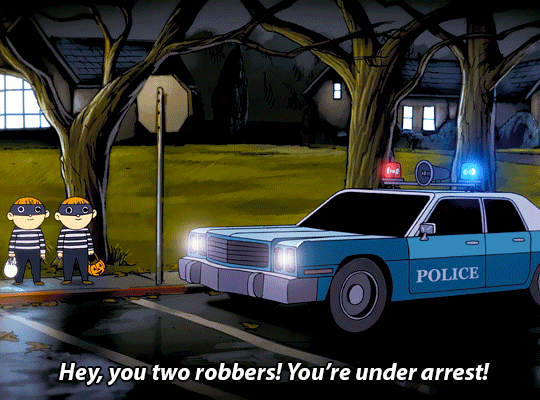
So why the nostalgia? I imagine it’s yet one more try and encourage mourning from its viewers. There are many days – and weeks and months – of the 12 months after we can criticize or choose the many years which OtGW pines for.
We are able to upbraid the Victorians for the imperialism, choose the Edwardians for his or her lack of ladies’s suffrage, indict the 20s for the return of the Klan, reject the 30s for the rise of fascism, and unload on the 70s and 80s for negligent parenting, shallow consumerism, and local weather crimes.
And all of those accusations can be simply and truthful.
However in the course of the mild reflectiveness of Hallowtide, McHale invitations us to take a break from the fixed white noise of concern to easily mourn the passage of time and the lack of our innocence. In some unspecified time in the future we had been trusting, beneficiant, and expressive, like Greg, and most of us (to as soon as once more paraphrase G. Ok. Chesterton) have grown outdated in our souls – skepitcal, jealous, and repressed – like Wirt. The explanations are unimportant, and sure justified, however our path again to the Good Life should cross by means of the darkish woodland of wholesome mourning.
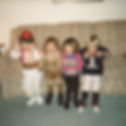
We are able to keep in mind our grandmother’s snort and hugs and neglect the wreaths of cigarette smoke seeping from her ashtray into our lungs. We are able to recall our uncle’s humorous tales about our dad’s childhood however neglect his horrifyingly racist jokes that went unchallenged. We are able to assume again on the time we spent swapping combined CDs with our cousin (the one who OD’d from fentanyl after shedding his custody battle 4 years in the past) with out remembering the apparent warning indicators of his deadly self-loathing.
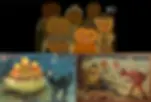
Our nostalgia permits us to like them as they ought to have been, not as they had been, however someplace on this childlike forgiveness is a deep and wealthy love – a love like that of Greg for Wirt (Greg who doesn’t abandon Wirt for being cynical and self-sabotaging, however who sacrifices himself for who Wirt might be in a greater world).

If this appears overly beneficiant – in case you really feel that justice is being miscarried by a naïve impulse to excuse unpardonable offenses – ponder this: what if you had been graciously and patiently cherished for who you might be by somebody who is aware of all too effectively who you actually are, warts and all. It might be the love of a kid, or a mom, or a grandfather: the love we do not deserve, however which our ravenous souls so desperately crave.
Even when we have not been lucky sufficient to be granted this love, maybe we now have it in inside our energy to expertise it by chosing to offer it away to others, even the undeserving. Maybe that is how we are able to begin to heal…
“WE NEED TO DO OUR PART TO MAKE
THE WORLD A BETTER PLACE!”
Ending Our Pilgrimage by means of the Unknown,
We Emerge with a Reward of Hope

And this brings us to our conclusion. As I discussed on the high, I am afraid that we now have additionally misplaced one thing alongside the way in which in our celebration of Hallowe’en – one thing which Over the Backyard Wall efficiently faucets and extends to us. So what’s it?
To be extra particular, a childlike marvel on the elegant (life/dying, nature/fantasy) and an equally childlike belief in our shared humanity. Till the previous few many years, Hallowe’en was largely a vacation based on social belief and communal safety (manifesting itself by means of inventive self-expression and collective generosity — see: Greg’s Gospel).
In the present day, Hallowe’en continues to take pleasure in collective participation, however it has grown – or seems to have grown, not less than from the place I’m sitting – more and more insular and neurotic over time. There appear to be fewer events and parades and extra guarded isolation. Exhausted and suspicious, we now have parted methods with group expression, turning inward with quiet desperation.

That is even evident within the shift in our monsters. This can be a stretch, however indulge me: as an alternative of dreading the incursions of inhuman, supernatural enemies – ghosts, vampires, monsters – our Hallowe’en aesthetic has grown more and more primarily based on our rising suspicion of each other : the very human threats of serial killers, masked maniacs, and contaminated zombies.


The sooner tropes positioned humanity in a joint, defensive posture – banding collectively towards frequent “non secular” enemies just like the Beast and what – however within the 2020s our emotions towards each other are paranoid and remoted, maybe trusting our pal circle, however viewing our fellow people as harmful liabilities slightly than potential allies. Persons are not the answer – they’re the risk. We’ve got misplaced our shared identification and – like Wirt – we’re circling a drain of cynical self-absorption and concern.
Finally they’ll be let down. Finally they’ll lose one thing or be damage. They won’t even survive. However – as we argued earlier – Greg’s Gospel additionally holds that “surviving” doesn’t imply residing – residing, actually residing, comes about by means of letting go and serving each other with open hearts.


I wish to shut our time along with a thought on Over the Backyard Wall‘s ending scene. Earlier than we’re proven a montage of reunions, reconciliations, and redemption, there’s a vital second – maybe simple to overlook – the place Greg parades his frog across the hospital room, with Lorna’s bell ringing and glowing within his abdomen. Lorna’s bell, we’ll recall, was a magic appeal with the facility to struggle off evil spirits – symbols of humanity’s non secular adversaries: concern, doubt, greed, hate, despair, nervousness, despair. And right here it’s in our waking world, this treasured, unasuming, sacramental, tinkling within the stomach of a child’s pet frog. On first viewing this appears cute or foolish, however having rewatched it, now it at all times brings tears to my eyes.
The bell peals out – gentle however true – no much less triumphant than the pounding clangor of a complete metropolis’s church steeples celebrating an important victory. Within this frog is an easy, easy-to-miss proof of the Brothers’ experiences, a little bit token of hope. Greg marches across the room, ringing the bell in an inviting benediction over the wonderstruck highschoolers, holding the frog up like a pair of stone tablets – a divine signpost pointing to the Good Life.

A really fundamental studying of the Unknown and of Wirt’s victorious emergence from it could assist inform our personal understanding of grief, concern, and nervousness. It’s all proper to enter the area of existential ache, in truth it’s vital. But when we keep there, we’ll grow to be caught — Edelwood timber rooted within the forest of uncertainty.
Nevertheless, if we are able to stand the darkness — if we are able to face and really feel our ache, confront our grief, and embrace our interior baby with grace and forgiveness — then we are able to emerge healed and made new.
And as with all Hero’s Journeys, we’ll emerge with a present: the reward of Hope — a present which helps empower us to reside out Greg’s Gospel: to belief our communities, to seek out pleasure in self-expression, and to love each other with beneficiant charity.
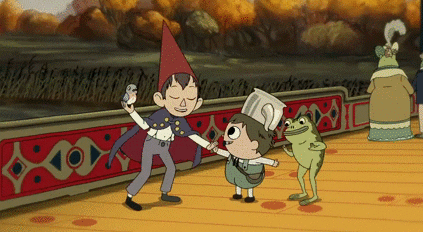
…as we exit this Hallowe’en, allow us to take pleasure in ourselves. Allow us to watch our favourite films (and 2014 miniseries), learn our favourite books, and take heed to our favourite homicide podcasts. However do not preserve all of it at residence.
Within the true spirit of Hallowe’en, mourn and keep in mind, greive and forgive, and — most significantly — share your life with individuals. Belief them, create with them, and be radically beneficiant with them. Have a good time with them. Band collectively towards the darkness and shine your collective lights in unity towards your respective Beasts. The loneliest pains on this life can actually be sanctified right into a “good grief,” if we enable ourselves to really feel them, and share them with these we belief to be our group.

Just like the Woodsman, nevertheless, this letting go is not only for us: it frees us as much as serve and love the opposite hurting individuals round us. By processing our grief and fears, we are able to heal as a species, and banish the darkish from our homes with the sunshine of our love – simply so long as we have been courageous sufficient to take a seat at midnight lengthy sufficient to call it.
That is what Hallowe’en is all about, and what it has at all times been all about.


